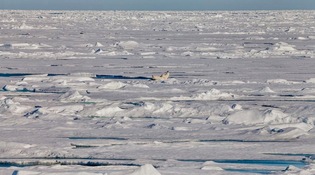 loading
loading
FindingsA danger in the ArcticAn undersea channel of warm water imperils the ice pack.  Andreas Weith/Wikimedia CommonsView full imageTo the dismay of Native subsistence hunters and polar bears alike, the Arctic ice pack has been gradually shrinking and thinning. Now, a grim discovery by a Yale oceanographer and colleagues suggests that the ice might disappear in a geological eye-blink. “The Arctic is the fastest-warming region of the planet,” says Professor Mary-Louise Timmermans, who worked on the study with scientists at the Woods Hole Oceanographic Institution, “and we found that the effects of warming in the summertime are actually present year-round.” Timmermans’s team analyzed physical measurements collected over 30 years by icebreakers and, more recently, by an array of Ice-Tethered Profilers—automated instruments that drift with the sea ice year-round and constantly stream data via satellite. The data revealed that a vast and stable layer of relatively warm water, close to 32 degrees Fahrenheit, lies some 150 to 450 feet below the frozen surface of the Arctic Ocean. (Salt water freezes at about 28.4 degrees Fahrenheit.) The warm layer originates in the Chukchi Sea, which lies between Alaska and Siberia and used to be a vast area of ice pack. But much of that ice has melted over the last 30 years. Now the sunlight that once would have reflected off the white ice shines straight into the water. The result: in the summertime, the Chukchi is absorbing five times the heat it used to. The prevailing current drags this warmer, saltier water underneath the surface. (The work was published in Science Advances.) This stream of “archived” aquatic warmth is currently trapped by the layers above it. But if conditions change and the stratification breaks down, Timmermans notes, the heat could be released almost overnight. “This would have dire consequences for the ice pack,” she says. “No doubt about it.”
The comment period has expired.
|
|